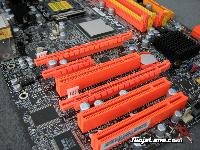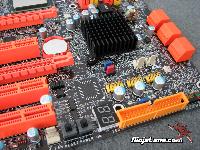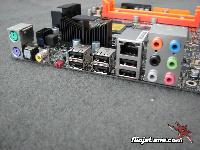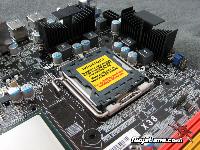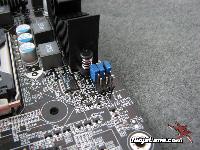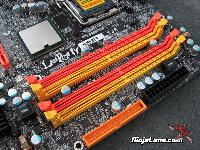After careful consideration I have decided to transfer all hardware review activities to a new domain. I purchased Hardwareasylum.com in 2012 and have been working hard to build a new and improved Ninjalane on that domain. If you are reading this you have reached one of the archived articles, news, projects and/or reviews that were left behind during the site migration.
Please update your bookmarks and be sure to visit the new and improved Ninjalane at Hardwareasylum.com
DFI LanParty Dark X38 Motherboard Review
Author: Dennis Garcia
Published: Thursday, May 15, 2008
Board Layout and Features
When we start a motherboard review like this the first thing we look at is the overall board layout including components and cooling. The expansion slot layout reflects the X38 feature set with 2 16x PCIe slots, 1 4x PCIe slot and 3 standard PCI slots.
This layout supports a Crossfire configuration however DFI did not include the bridging module.
This layout supports a Crossfire configuration however DFI did not include the bridging module.
In keeping with the Lanparty tradition you will find a digital POST code reader (helpful for troubleshooting), EZ Touch buttons for both power and reset. Several fan headers, Southbridge chipset and heatsink, CMOS jumper, front panel connector, floppy drive connector, USB, SATA, and Secondary RTC reset jumper (the one in blue). However the thing you won’t see is a BIOS chip!. We have no clue where it went 
There are 3 ways to clear the CMOS on the LanPartyDK X38. You can press both the power and reset EZ Touch buttons together for 5 seconds, or you can move the red CMOS jumper near the CMOS battery. The last option is to move the red CMOS jumper found on the ATX connector. This seems a little excessive in our eyes but sometimes that is faster than the alternative.
The ATX connector also features Digital audio connections, 6 USB ports, analog sound and a single RJ45.
There are 3 ways to clear the CMOS on the LanPartyDK X38. You can press both the power and reset EZ Touch buttons together for 5 seconds, or you can move the red CMOS jumper near the CMOS battery. The last option is to move the red CMOS jumper found on the ATX connector. This seems a little excessive in our eyes but sometimes that is faster than the alternative.
The ATX connector also features Digital audio connections, 6 USB ports, analog sound and a single RJ45.
In an attempt to keep material costs down the Dark edition motherboards feature analog 4-phase power supplies. They still use Japanese capacitors for quality and come with individual mosfet heatsinks to keep things cool.
Some of you may have noticed the 3 jumpers near the CPU socket. These are to manually control the FSB speed. The default configuration is “By CPU” however you can set these to any of the 3 major FSB speeds supported by the X38 (800/1066/1333)
The Intel X38 supports both DDR2 and DDR3 memory modules and its up to the motherboard maker to decide which. Our board sample, the T2R, is designed around the DDR2 memory platform and supports up to 8GB across 4 modules at speeds up to 800Mhz.
Of course there is nothing stopping you from using faster modules, in fact we encourage it.
The Intel X38 supports both DDR2 and DDR3 memory modules and its up to the motherboard maker to decide which. Our board sample, the T2R, is designed around the DDR2 memory platform and supports up to 8GB across 4 modules at speeds up to 800Mhz.
Of course there is nothing stopping you from using faster modules, in fact we encourage it.

